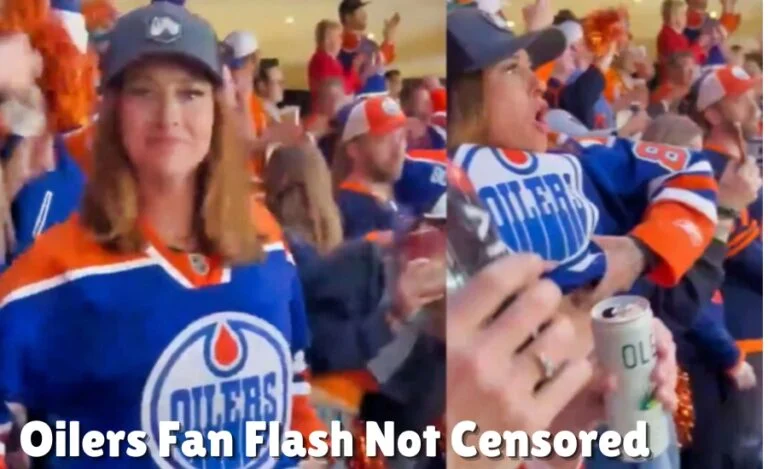The Viral Oilers Fan Flash Not Censored: Everything You Need to Know and Why It Still Matters

In a world where moments can go viral within seconds, the Oilers fan flash incident became a hot topic on social media, sparking intense reactions and discussions across the internet. During Game 5 of the Western Conference Finals between the Edmonton Oilers and the Dallas Stars, one fan’s bold move caught the attention of millions. With cameras rolling and social media ready to explode, this moment would go down in history as one of the most talked-about fan incidents of the year. For those searching for the “oilers fan flash not censored” clip, the uncensored version has been circulating in different corners of the internet, creating quite the buzz.
In this article, we dive deep into what happened, why it matters, and the bigger picture behind such viral moments. From the fan’s spontaneous decision to the massive online reaction, this event has left an imprint on sports culture that extends beyond the ice rink.
The Incident – What Really Happened?
It was Game 5 of the Western Conference Finals, and tensions were high. The Edmonton Oilers were battling the Dallas Stars, and the game was intense. But what stole the spotlight that night wasn’t just the game—it was a particular fan in the stands. During a crucial moment, an Edmonton Oilers fan, later identified as “Kate,” decided to lift her jersey and flash the crowd. It wasn’t long before cameras caught her mid-act, and in the blink of an eye, the moment was shared across social media platforms.
Fans at the game and those watching at home were quick to react. Some cheered, others were shocked, but one thing was certain: this wasn’t just a fleeting moment. Kate’s flash became a viral sensation. The clip, particularly those that were “not censored”, spread like wildfire on platforms like Twitter and Reddit, gathering millions of views and reactions.
So, why did this seemingly small act make such a big splash? The timing was perfect: the Oilers had just taken a lead in the series, emotions were running high, and sports fans online are always on the lookout for unexpected moments like these to make memes and create viral content.
The Internet’s Reaction
The internet has a way of amplifying moments, and the Oilers fan flash was no exception. On platforms like Twitter, the uncensored video was viewed over 28 million times within a short period, with over 320,000 likes and 179,000 bookmarks. Twitter users flooded the comments section, creating a storm of reactions ranging from jokes to surprise and admiration.
It wasn’t just the numbers that were astounding, but the nature of the online engagement. Users shared their thoughts on the incident, with some making light of the situation, and others offering serious debates on sports culture and public behavior. Memes quickly followed, and soon, even unrelated events had references to the now-famous flash.
Kate herself even chimed in during an interview, mentioning how the incident was not planned and was largely fueled by her excitement and, admittedly, a few too many drinks. Her explanation, combined with the viral nature of the event, only fueled further interest. It wasn’t long before adult entertainment companies, such as CamSoda, were offering her employment opportunities to replicate the act for money—up to $100,000, according to reports.
But the story didn’t stop there. As with many viral moments, the “oilers fan flash not censored” video started to circulate on various other platforms, from TikTok to Instagram, where the content rules often differ. Some platforms allowed the uncensored version, while others removed it quickly. This balance between censorship and free speech became part of the larger conversation.
The Impact on Sports Culture

Viral fan moments are not new to sports, but this particular incident raises a few important questions about the role of fans at live events. Sports arenas are places filled with energy, where fans feel a sense of community and freedom. However, when a fan’s actions cross certain boundaries, the moment can shift from harmless fun to something more problematic.
This isn’t the first time a fan has gone viral at a game, but the Oilers fan flash stood out because of the intensity of the reactions. Some viewed it as a bold act of celebration, while others saw it as inappropriate behavior. It brings up questions about how fans are expected to behave in public and how much freedom they have when the camera is always rolling.
Moments like this one have become part of the fabric of sports culture. Fans are no longer passive viewers—they are active participants in the spectacle, influencing the game’s narrative in real-time. This is further amplified by the internet, where viral moments can overshadow the game itself.
The “oilers fan flash not censored” video also reflects the shift in how sports are consumed in the digital age. Instead of just focusing on the game, many people now engage with the off-field drama, which has become just as important. The virality of such moments has raised questions about the boundaries between fan enjoyment and appropriate conduct.
Ethical Concerns and Media Coverage
The media coverage surrounding the Oilers fan flash incident was extensive, but not without controversy. Many news outlets covered the story, some providing censored versions of the footage, while others allowed the uncensored clips to remain available. This raises ethical questions about the role of media in amplifying such moments. Should media outlets be responsible for what they broadcast and share, or is the onus on the viewer?
Moreover, there’s the issue of consent. Even though Kate willingly flashed the crowd, the rapid spread of the footage across the internet without her explicit permission creates a dilemma. Does a person lose control of their image once they go viral, and how much responsibility do media platforms have in managing explicit content?
The fact that many versions of the “oilers fan flash not censored” video remained accessible for a significant time despite content moderation policies highlights the challenges social media companies face in balancing free expression with responsibility. It also shows the complexities of moderating user-generated content in real-time during a viral moment.
Google’s Role in Censoring Content
Search engines like Google play a critical role in determining what content people can access online. When it comes to explicit or viral content, Google’s guidelines are strict, often favoring censored versions or removing inappropriate material from search results altogether.
For this particular incident, those searching for the “oilers fan flash not censored” clip may have encountered mixed results. While some platforms hosted the uncensored versions, many more reputable outlets only showed edited clips or removed them entirely to comply with content guidelines. Google’s algorithms prioritize responsible content, and creators who abide by these rules are more likely to maintain visibility on the platform.
Understanding these guidelines is crucial for content creators and marketers, especially when dealing with sensitive topics. Google’s focus on E.A.T. (Expertise, Authoritativeness, Trustworthiness) means that creating ethical, accurate, and well-researched content is key to maintaining online presence and avoiding penalties.
You May Also Like: Steve-Sears-Pleasant-View-Tn
Fan Reactions and Personal Responsibility

The reaction of fans is often mixed when such incidents occur. Some celebrate the spontaneity and excitement, while others point out the potential harm or inappropriateness of the action. The Oilers fan flash raised debates about personal responsibility at live events. Should fans be mindful of their actions in public, especially in an age where everyone has a camera?
Kate’s decision to flash wasn’t premeditated, but the consequences were significant. The internet’s power to amplify small moments turned this into a global spectacle. It serves as a reminder that in today’s world, personal moments can quickly become public property.
The Broader Conversation on Virality and Internet Culture
The Oilers fan flash incident is a case study in how virality works in modern culture. Moments like these catch fire not just because they are shocking or funny, but because they tap into deeper conversations about fame, behavior, and the internet. Viral content has become an integral part of how we experience events in real-time, with the potential to overshadow the events themselves.
In the future, sports teams and fans alike may need to rethink how they engage with these moments. Is there a way to celebrate in the heat of the moment without crossing lines? And what does it mean for fans when one viral act defines a significant part of the conversation?
Conclusion
The Oilers fan flash incident was more than just a viral moment—it was a reflection of the changing nature of fan culture and internet virality. The video, particularly the “oilers fan flash not censored” clip, became a sensation because it tapped into a unique combination of sports excitement, fan behavior, and digital amplification.
As sports and internet culture continue to evolve, incidents like this will raise important questions about privacy, media ethics, and the role of fans. While the flash may fade from the headlines, the discussions it sparked will likely continue for a long time.
FAQs
Q: What happened during the Oilers fan flash incident?
A: During Game 5 of the Western Conference Finals, an Edmonton Oilers fan flashed the crowd, which was caught on camera and quickly went viral on social media.
Q: Why did the Oilers fan flash go viral?
A: The incident went viral due to the fan’s spontaneous act being captured on camera and widely shared across social media platforms, especially in its uncensored form.
Q: Who is the fan involved in the Oilers flash incident?
A: The fan was later identified as “Kate,” who explained in an interview that the moment was not planned and happened in the excitement of the game.
Q: Where can I find the uncensored Oilers fan flash video?
A: The uncensored version of the video circulated across social media platforms like Twitter, but it has been removed or censored on many reputable sites.
Q: What were the reactions to the Oilers fan flash?
A: Reactions were mixed, with some finding it amusing and others seeing it as inappropriate. It sparked a larger discussion about fan behavior at sporting events.
Q: Did the Oilers fan face any consequences for her actions?
A: While Kate did not face legal consequences, she expressed embarrassment in interviews and mentioned trying to keep a low profile after the incident.
Q: What is the broader impact of the Oilers fan flash incident?
A: The incident highlights how quickly viral moments can spread and the ongoing conversation around fan behavior, internet culture, and media coverage.
Get the Latest Updates On ILOUNGE

Specializing in insightful and engaging articles across a range of topics. With a keen eye for detail and a passion for delivering high-quality information, Mary helps readers stay informed with the latest trends and updates


